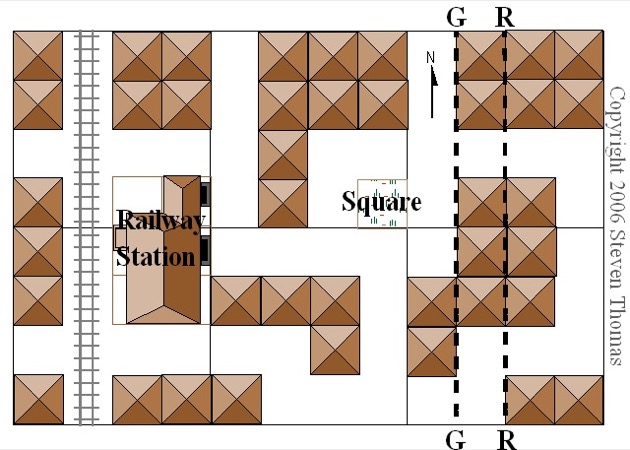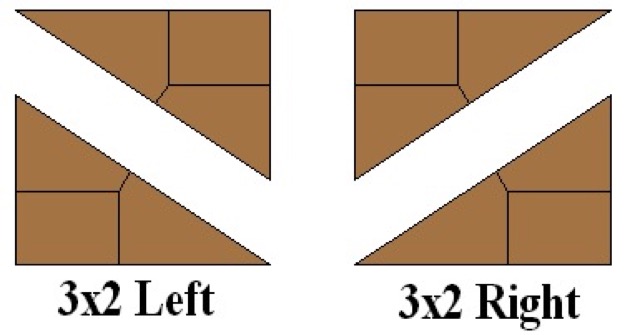A while ago I played a Crossfire game called 2 Foot City. It was fought on a 2’x2′ cityscape. Since then I’ve played a few more games in heavily built up areas and they have all been on an assumed square grid. The trouble with a square grid is you only get streets that exactly fit the grid, i.e. vertical or horizontal, with no diagonals. Lately I’ve been wondering how to superimpose diagonal streets on my urban grid.
The Urban Grid
To date all have a map with a grid and the buildings fit within a square grid. Each building sector fits one of the smaller cells in the Urban Grid. In my case each normal building sector is a 3″ x 3″ square, so you can get 16 of these within one foot square on the table. A building complex fills a number of these cells. Streets it the grid as well and are the gaps between buildings.

For example my Tarnopol: SU152s Up Close and Personal was on a 3′ x 2′ table and fits exactly within the Urban Grid above.

Diagonal Streets on the Urban Grid
I fiddled around a bit but ended up deciding to build matching triangular blocks to create the diagonal streets. Each matched pair of triangular blocks forms a larger city block with a diagonal street through the middle.
These are the guidelines I came up with for my triangular blocks:
- Each triangular block is a triangle (ok, that was obvious).
- The larger city blocks formed by the matched triangular blocks must fit exactly within the urban grid. That means the pair form a square or rectangle covering the floor area of a certain number of normal building sectors.
- Where possible use a square or rectangular building sectors within the triangular blocks. But these don’t have to the same size and shape as a normal building sector.
- Internal walls meeting an external wall do so at a 90 degree angle (except at a corner).
- Each corner of a triangular block has only one building sector rather than two meeting at the corner. This wasn’t always possible.
- Each building sector within the triangular blocks must have at least the same floor area as a normal building sector. For example, a pair 3 x 3 triangular blocks has the floor area of nine normal building sectors, but I only gave each such triangular block four building sectors to ensure I didn’t end up with a half size building sector.
- Irregular building sectors are ok – in fact essential to meet the guidelines above.
Symmetrical triangular blocks
The main pieces are triangular pieces that are symmetrical. I made these from a square divided into two even triangles. With the street through the middle these actually form rectangular city blocks. I made four sizes. The first three pairs were made from a square the size of:
- 4 x 4 normal building sectors (i.e. a square big enough to have four rows and four columns, 16 total, of normal building sectors)
- 3 x 3 normal building sectors
- 2 x 2 normal building sectors
The last symmetrical set had four triangles made from another square that is the size of 2 x 2 normal building sectors. Each triangular block is the same area as a normal square building sector.

Combinations of Symmetrical triangular blocks
Actually you can match up non-identical blocks to form perfectly square city blocks with a diagonal street through it. In each of these examples a triangular block is matched with the next smaller triangular block.

Asymmetrical triangular blocks
I also made some asymmetrical triangular blocks. Each pair was made from a rectangle that is 3 x 2 normal building sectors. One pair had the diagonal going one direction (up to the left) and the other pair had the street going in the other direction (up to the right).

Examples of Diagonal Streets
The thing that got me actually making the triangular blocks was my Carabanchel Scenario. If you look at the real Carabanchel area of Madrid you’ll see that the streets do not form a neat grid and several streets are angled. I wanted a table that reflected that, even if it wasn’t an exact match of the real street layout. For this map I’ve broken the Urban Grid a tad to enable the building sectors in the Military Hospital to be larger than normal.






